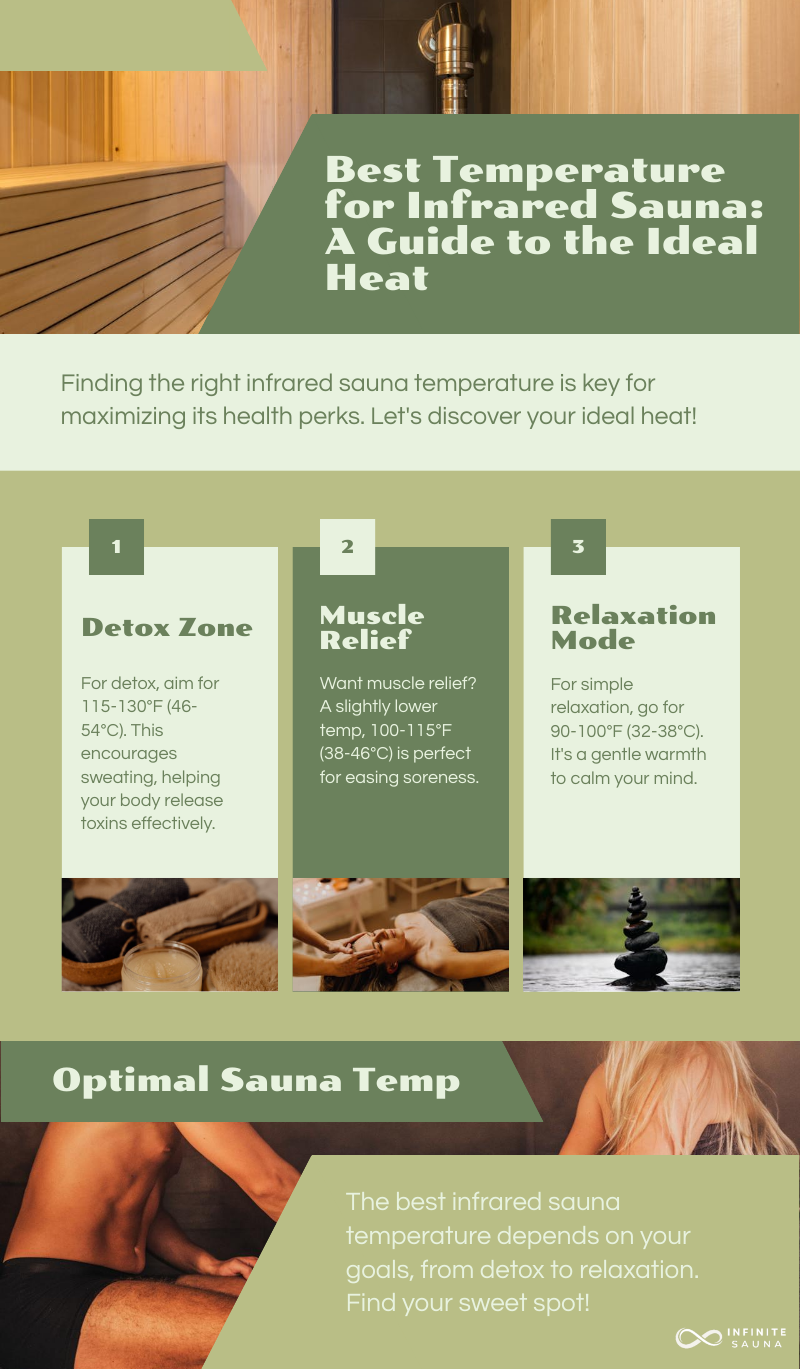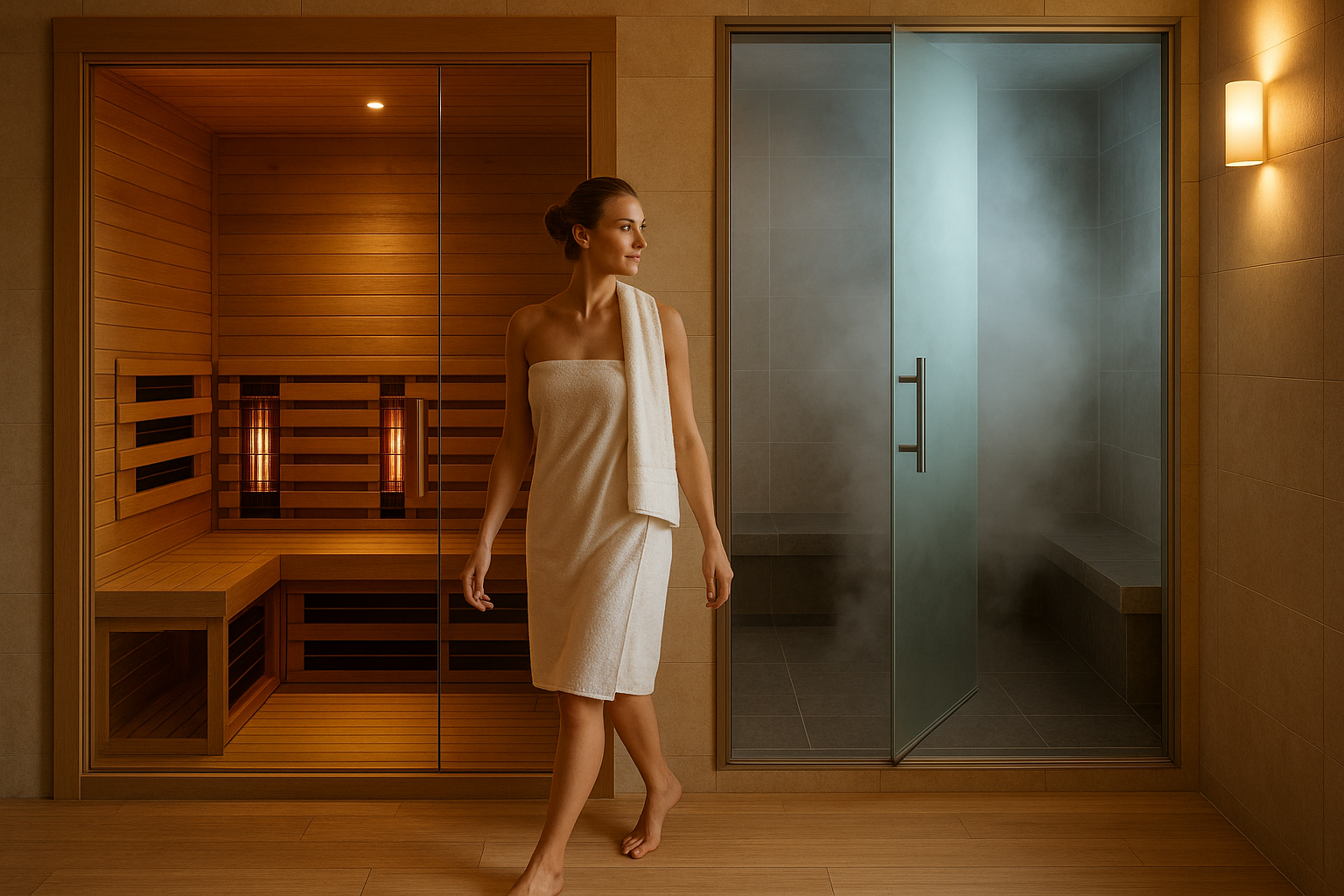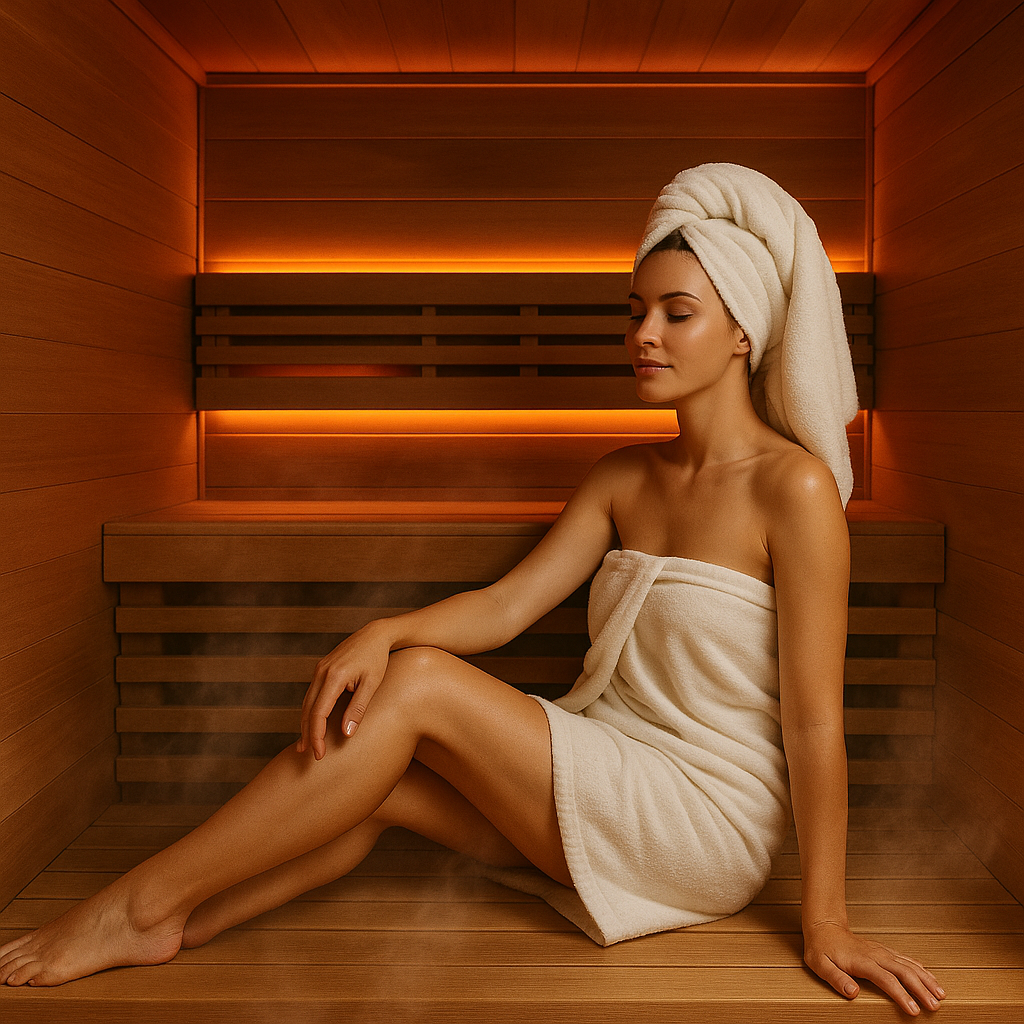Best Temperature for Infrared Sauna: A Guide to the Ideal Heat for Wellness
Are You Using Your Infrared Sauna at the Right Temperature?
Dial In Your Heat: Unlock the Full Potential of Your Infrared Sauna
You’ve invested in a premium infrared sauna—a decision rooted in your desire for better health, deeper relaxation, and smarter self-care. But here’s the question no one asks until results stall: Are you using it at the right temperature?
Just like nutrition and fitness, infrared sauna effectiveness isn’t one-size-fits-all. Your sauna’s temperature impacts everything from how deeply you detox to how well you recover after a workout. Set it too low and you won’t break a sweat. Too high? You risk discomfort, dehydration—or cutting your session short without reaping the benefits.
So, what’s the best temperature for an infrared sauna? And how does it vary based on your wellness goals?
This guide breaks down the optimal temperature ranges based on your wellness goals, backed by real science, practical experience, and decades of industry insight. Whether you’re aiming for detox, pain relief, fat loss, glowing skin, or better sleep, we’ll show you exactly how to customize your sessions.
What Is the Ideal Temperature Range for an Infrared Sauna?
Most infrared saunas operate best between 110°F and 140°F (43°C to 60°C). That’s notably lower than traditional Finnish saunas, which often reach 180°F or more. But don’t confuse lower air temps with weaker results.
Infrared saunas heat the body directly using light wavelengths, allowing deeper penetration into muscles and tissues—without scorching your skin or overheating your environment.
| Sauna Type | Temperature Range |
|---|---|
| Traditional (Finnish) | 150°F–190°F (65°C–88°C) |
| Infrared (General) | 110°F–140°F (43°C–60°C) |
| Near Infrared (NIR) | 100°F–130°F (38°C–54°C) |
| Far Infrared (FIR) | 120°F–140°F (49°C–60°C) |
| Full Spectrum | 100°F–140°F (38°C–60°C) |
Why Lower Temps Work: The Infrared Advantage
Infrared saunas don’t need to heat the air around you to extreme levels. Instead, they use invisible light waves that directly warm your body, allowing for deeper sweat and cellular activation—all at safer, more comfortable temperatures.
Temperature by Health Goal: What Works Best?
🔬 Detoxification & Heavy Metal Elimination
Ideal Range: 125°F–135°F
At this range, you trigger cellular-level sweating, proven to increase excretion of toxins like mercury, lead, and cadmium. A study in Archives of Environmental and Occupational Health confirmed infrared-induced sweat contains higher concentrations of heavy metals than passive sweating.
💡 Tip: Hydrate with electrolyte-rich water pre- and post-session to support kidney and liver detox pathways.
🏋️♀️ Muscle Recovery & Pain Relief
Ideal Range: 120°F–130°F
Infrared heat boosts blood flow and helps your muscles receive more oxygen and nutrients—reducing inflammation, stiffness, and soreness. Athletes and those with chronic pain (like arthritis or fibromyalgia) benefit greatly from this temperature zone.
⚡ Pro Tip: Pair with Red Light Therapy Saunas to enhance mitochondrial repair and reduce DOMS (Delayed Onset Muscle Soreness).
🔥 Weight Loss & Metabolism Boost
Ideal Range: 130°F–140°F
At higher temperatures, your heart rate and metabolic activity increase, mimicking light cardiovascular exercise. A JAMA Internal Medicine study found sauna users had lower risk of cardiovascular disease and all-cause mortality—benefits closely tied to elevated core body temp.
🎯 Curious about the burn? Use our Sauna Calorie Calculator to estimate how many calories you torch per session.
✨ Skin Health & Anti-Aging
Ideal Range: 115°F–125°F
Infrared therapy stimulates collagen, clears pores, and enhances circulation—making it ideal for acne-prone or aging skin. Lower temps are gentler on sensitive skin yet still powerful enough to encourage cell turnover.
🌿 Users report fewer breakouts, smoother texture, and a healthy glow within just a few weeks of regular sessions.
😴 Stress Relief & Improved Sleep
Ideal Range: 110°F–120°F
This gentle heat activates your parasympathetic nervous system, allowing your body to shift from “fight or flight” to “rest and digest.” A 20–30 minute session in this range can boost melatonin, lower cortisol, and help you unwind before bed.
🛌 Try it nightly and watch your sleep quality transform—especially when combined with breathwork or meditation.
🛍️ Ready to Experience the Right Heat? Explore the Best Full Spectrum Saunas
Full spectrum saunas allow you to target multiple wellness goals in one session by combining near, mid, and far infrared wavelengths. They also offer the widest, most customizable temperature range (100°F to 140°F).
➡️ Browse Full Spectrum Infrared Saunas to find the model that fits your space and lifestyle.
If you’re still figuring out the right setup, take our quiz to discover which infrared sauna matches your wellness goals, space, and lifestyle.

Infrared Sauna Tips for a Safer, More Effective Session
Getting the most from your infrared sauna isn’t just about dialing in the right temperature. It’s about preparing your body, using the sauna mindfully, and recovering properly. Here’s how to make every session safer and more beneficial:
✅ Hydrate Beforehand and Afterward
Why it matters: Infrared saunas promote deep sweating, which means significant fluid loss. Even mild dehydration can lead to fatigue, headaches, and dizziness—undermining the benefits of your session.
Pro tip:
- Drink at least 16–20 oz of water 30–60 minutes before your session.
- Add electrolytes (such as magnesium, potassium, and sodium) to replenish minerals lost through sweat.
- Post-session, continue hydrating steadily throughout the day. Coconut water, mineral water, or electrolyte packets can be especially helpful.
✅ Use a Towel to Absorb Sweat
Why it matters: Sitting on a towel absorbs sweat and prevents it from pooling on the bench, which keeps the sauna cleaner and more hygienic. It also prevents your skin from reabsorbing toxins excreted during the session.
Pro tip:
- Use one towel to sit or lie on, and another to wipe sweat from your face and neck.
- Choose cotton or bamboo towels—they’re more breathable and less likely to harbor bacteria.
✅ Start Slow and Build Tolerance
Why it matters: Infrared sauna therapy is powerful. If you're new to it, diving into high temperatures or long sessions too quickly can cause lightheadedness, nausea, or excessive fatigue.
Pro tip:
- Start at 110°F–120°F for just 10–15 minutes, especially if you’re new to sauna use.
- Gradually increase session length and temperature over time based on how your body responds.
- Listen to your body. If you feel dizzy, fatigued, or uncomfortable, exit the sauna immediately.
✅ Avoid Eating Heavy Meals Before Sessions
Why it matters: A full stomach draws blood toward your digestive system. This can interfere with thermoregulation and make you feel sluggish or nauseous during your session.
Pro tip:
- Wait at least 1–2 hours after a heavy meal before entering the sauna.
- If you need a small snack beforehand, opt for something light and easily digestible like a banana, smoothie, or a handful of nuts.
✅ Set a Timer to Avoid Overuse
Why it matters: It’s easy to lose track of time while relaxing in a sauna, but staying in too long can lead to overheating or dehydration—especially at higher temperatures.
Pro tip:
- Use a built-in digital timer or a smartphone timer to track your session.
- Most people benefit from 20–45 minutes, depending on experience, temperature, and health status.
- Beginners should cap their sessions at 20–25 minutes and increase only as they adapt.
✅ Cool Down Gradually Post-Session
Why it matters: Your body needs time to return to baseline after intense heat exposure. A proper cooldown helps regulate heart rate, normalize blood pressure, and prevent dizziness.
Pro tip:
- Step out and sit or lie down in a cool (but not cold) space for 5–10 minutes before showering.
- Follow up with a lukewarm or cool shower to rinse off sweat and close pores.
- Avoid sudden cold plunges unless you're experienced and your body is conditioned for it.
Beginner vs. Advanced: How to Adjust Over Time
| Experience Level | Recommended Temp | Session Duration |
|---|---|---|
| Beginner (Weeks 1–3) | 110°F–120°F | 15–25 minutes |
| Intermediate | 120°F–130°F | 25–35 minutes |
| Advanced | 130°F–140°F | 30–45 minutes |
As your body adapts, you’ll notice sweating starts earlier and you can handle longer sessions without fatigue. Listen to your body—it’s your best guide.
FAQ: Quick Answers to Infrared Sauna Temperature Questions
❓ Is hotter always better?
No. Higher heat doesn’t guarantee better results. Aim for a temperature you can sustain comfortably for 30–45 minutes. Deep sweating at moderate temps is more effective than overheating and quitting early.
❓ How long should I stay in?
20 to 45 minutes is ideal. Start with 15–20 minutes if you're new, then gradually build up as you adapt.
❓ Can I change the temperature mid-session?
Yes. Most saunas have digital controls. Adjust as needed based on how you feel. Lightheaded? Step out or lower the temp.
❓ What's best for first-time users?
Start at 110°F to 120°F and focus on hydration, comfort, and shorter sessions. Let your body ease into the experience.
❓ What’s the right temp for a full spectrum sauna?
100°F–140°F, depending on your goal. This type is great if you want one unit for detox, weight loss, and pain relief all in one.
Types of Infrared Heaters and Temperature Impact
- Carbon Heaters: Provide broader heat distribution at lower temps
- Ceramic Heaters: Offer higher surface temps but focused heat zones
- Full Spectrum Panels: Most versatile, targeting multiple health goals
The type of heater influences how quickly your sauna reaches its target temperature, so it’s important to choose based on your space and goals.
➡️ Explore Infrared Heater Options: Sauna Heaters Collection
Scientific Evidence Supporting Infrared Sauna Temperature Ranges
Numerous peer-reviewed studies have confirmed the physiological and cardiovascular benefits of infrared sauna use:
-
Laukkanen et al. (2015): Regular sauna use (2–7 times/week) at 120°F–140°F reduced all-cause mortality.
-
Frequenting the sauna appears to be connected to a reduced risk of number of cardiovascular conditions including heart failure and coronary heart disease and ultimately lead to a longer life, according to a new study in journal JAMA Internal Medicine.
-
Harvard Health Publishing – Confirms saunas can improve circulation, lower blood pressure, and support detox pathways.
Set It Right, Feel the Difference
If you're not optimizing your sauna temperature, you’re leaving wellness benefits on the table. But now, you know better—and you can do better.
To recap:
- 110°F–120°F: For stress relief, sleep, and beginners
- 120°F–130°F: Ideal for muscle recovery and pain
- 130°F–140°F: Perfect for fat burning and deep detox
The sweet spot is what feels sustainable and effective for your specific body and goals. Don’t chase the highest number—chase the best outcome.
Additional Resources: Scientific Studies on Infrared Sauna Benefits
- Effect of post-exercise sauna bathing on the endurance performance of competitive male runners
- Clinical implications of thermal therapy in lifestyle-related diseases










Leave a comment
This site is protected by hCaptcha and the hCaptcha Privacy Policy and Terms of Service apply.